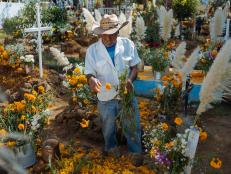Celebrate Mexican Culture in Cirque du Soleil's "Luzia"
Travel Channel takes you behind the scenes at "Luzia," to learn about Mexico's fascinating history and traditions.
Related To:

Photo By: Matt Beard/Cirque du Soleil
Disk of Luzia
Traveling the country with stops in Atlanta (through November 19), Los Angeles (Dec. 8-Jan. 21) and Costa Mesa (Feb. 21-March 18), "Luzia" is Cirque du Soleil's colorful, vibrant celebration of Mexico and its rich heritage. "Luzia" is filled with references to Mexican cinema, art, handicraft, religion and history including the bright yellow orb that reappears throughout the production; the Disk of Luzia. The disk references the sun, the moon and the Aztec calendar. But the disk also pays tribute to the Teotihuacan archeological site which features some of the most architecturally notable Mesoamerican pyramids of the pre-Columbian Americas built around 100 C.E.
Surreal Menagerie
Mexican culture is deeply informed by the animal world. In the ancient Mesoamerican concept of the "nagual" the spirit of an animal is said to live in every human being from birth, guiding and protecting them throughout their lives. The infusion of animals into Mexican consciousness appears in local lore and mythology and is expressed in a variety of half-human, half-beast creatures seen throughout "Luzia."
Otomi Print
The Otomi people, an indigenous group who inhabit Mexico's central plateau region, are known for embroidery inspired by the natural world. In "Luzia"'s grand finale, costumes are decorated with the flora and fauna motifs that distinguish the Otomi style.
Lucha Libre
The popular Mexican pastime of professional wrestling gets a shout out in this luchador costume featured in "Luzia."
The Papel Picado Curtain
Paper Lantern
The enormous Papel Picado lantern that descends onto the "Luzia" stage is decorated with motifs seen throughout the show and also seen in Mexican life like hummingbirds, a plaza, desert cacti and a field of flowers.
Cenote
Cenotes are natural sinkholes that were often used in Aztec religious rituals. They are referenced in "Luzia" in an Aerial Straps act in which a circus artist representing a god-like figure performs at the center of a cenote.
An Homage to Mexican Cinema
The Adagio act in "Luzia" features an homage to the golden age of Mexican cinema and is inspired by the classic 1949 film "Salon Mexico" directed by Emilio Fernandez.
The Running Woman
"Luzia"'s Running Woman is inspired by the Tarahumaras tribe from the mountains of northwestern Mexico who were known for their incredible long-distance running skills.
Dream-Like Jungle
Acrobats in this "Luzia" number wearing reptilian costumes perform incredible acrobatic feats. The performers climb and leap through this surreal jungle scene inspired by the hallucinogenic properties of peyote.
A Desert Cactus
Quiotes (agave plants) and cacti (like the one shown here) are featured throughout "Luzia" in a nod to the exotic Mexican landscape. Agave plants are also the source of the Mexican spirits mezcal and tequila.
Rain
Refreshing, violent, nurturing, the diverse rains that fall across Mexico are an essential part of the Mexican collective consciousness and are referenced throughout "Luzia."
Animal Puppets
A life-size horse and jaguar puppet are featured prominently throughout "Luzia." Horses were introduced to Mexico by the Spanish and became beloved companions of Mexican revolutionaries like Pancho Villa and Emiliano Zapata. Jaguars were prominent in Mayan and pre-Hispanic mythology and seen as human companions in the spiritual world.
Human Hummingbirds
Hummingbirds are important creatures in Aztec culture. Those who died in battle or under traumatic circumstances were believed to return to earth as hummingbirds. The lyrical, colorful creatures are featured in the Hoop Diving act of "Luzia."
Futbol
Beloved in Mexico, futbol—or soccer—is celebrated with feats of balance and agility in an engaging "Luzia" sequence dedicated to the sport.



